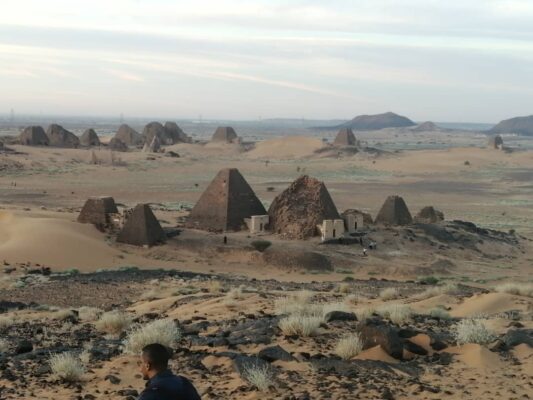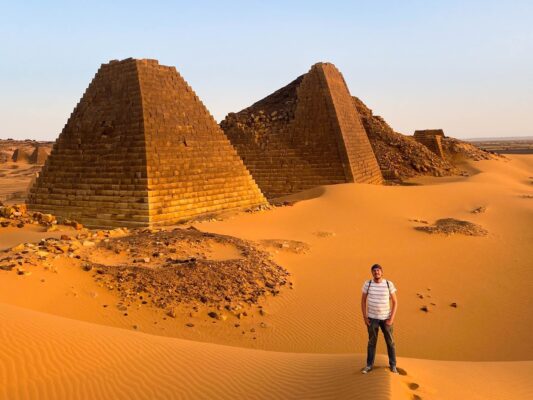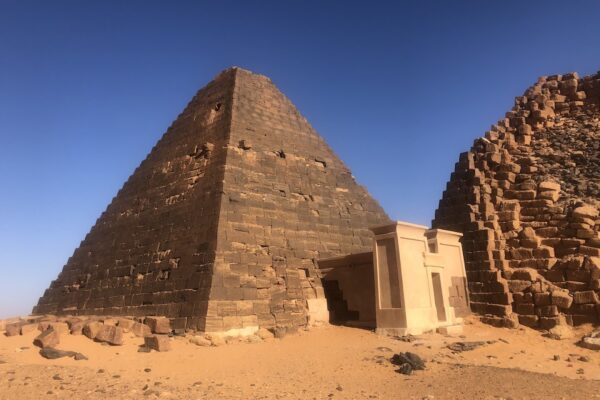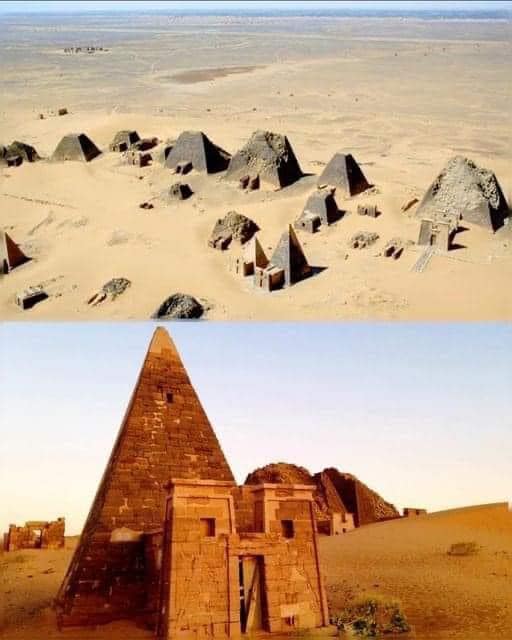Nestled deep within the arid expanse of the Sudanese desert lies the ancient city of Meroë, an archaeological treasure and the heart of the Kingdom of Kush. Famous for its over 200 pyramids, Meroë offers a unique glimpse into a civilization that rivaled ancient Egypt in cultural and architectural grandeur. Follow archeology.dulichvn.net to discover many hidden mysteries that have yet to be discovered.

The Ancient City of Meroë
The Historical Significance of Meroë
Meroë, the royal capital of the Kingdom of Kush from approximately 800 BCE to 350 CE, stands as a testament to the grandeur and influence of one of Africa’s most advanced ancient civilizations. Strategically located along the Nile River, Meroë became a thriving hub of commerce, connecting the African interior with the Mediterranean, the Arabian Peninsula, and beyond. This strategic position enabled the city to flourish as a center for trade, with goods such as gold, ivory, iron, and exotic animals flowing through its bustling markets.
The city’s wealth and cultural sophistication are reflected in its impressive architectural achievements, including intricately designed temples, elaborate royal tombs, and the iconic pyramids that dominate its landscape. These structures, adorned with detailed carvings and inscriptions, serve as enduring symbols of the Kingdom of Kush’s artistic and spiritual traditions.
The Layout of Meroë
The city of Meroë was meticulously organized into distinct sections, each serving a specific purpose. The royal necropolis, located on the outskirts, is home to over 200 pyramids that housed the remains of Kushite kings, queens, and nobles. These pyramids, with their steep angles and pointed tops, stand in stark contrast to their Egyptian counterparts and reflect the unique cultural identity of the Kushite civilization.
Within the urban core, archaeologists have uncovered evidence of thriving residential neighborhoods, opulent palaces, and grand temples dedicated to a pantheon of gods. The city also boasted advanced infrastructure, including a sophisticated water management system with reservoirs and canals, enabling its inhabitants to cultivate crops and sustain life in the harsh desert environment. This ingenuity underscores the Kushites’ mastery of engineering and their ability to adapt to challenging conditions.
UNESCO World Heritage Status
In 2011, Meroë was designated a UNESCO World Heritage Site, recognizing its immense historical and cultural significance. This prestigious acknowledgment has not only helped to preserve the site but also elevated global awareness of the Kingdom of Kush’s contributions to human history.
As a UNESCO site, Meroë benefits from international efforts to protect its fragile structures from environmental and human threats. The designation has also boosted tourism, drawing visitors eager to witness the splendor of this ancient city and learn about its rich legacy. Meroë stands as a symbol of Africa’s historical depth and cultural diversity, offering valuable insights into the achievements of a civilization that once rivaled the great powers of its time.

The Unique Pyramids of Meroë
Distinctive Architecture of the Meroë Pyramids
The pyramids of Meroë present a striking contrast to the towering structures of Egypt’s Giza plateau. While the Egyptian pyramids are immense and grand, the pyramids of Meroë are smaller, more intimate, and distinguished by their steep, sharply angled slopes. Built primarily from local sandstone blocks, these pyramids have a more compact and elongated shape, with pointed tops that rise dramatically against the vast desert landscape. The overall silhouette they create is both visually arresting and enigmatic, giving the pyramids an otherworldly presence as they stand in isolation under the African sky.
Purpose and Symbolism of the Meroë Pyramids
The pyramids at Meroë were not simply architectural marvels; they served as sacred royal tombs, primarily for the kings and queens of the Kingdom of Kush. These structures were intended to facilitate the passage of the deceased into the afterlife, a journey that was deeply embedded in the spiritual beliefs of the Kushite people. Each pyramid was meticulously designed to honor the deceased monarchs, with elaborate walls and chapels featuring intricate carvings and bas-reliefs. These artworks depict the accomplishments of the deceased, along with scenes from Kushite religious rituals and mythology, illustrating a seamless blend of art, faith, and history.
The symbolism of the pyramids extends beyond their function as tombs. Their design reflects the divine status of the royal family and their close connection to the gods. The pointed peaks were likely intended to symbolize a connection between the earthly realm and the heavens, reinforcing the idea of eternal life for the rulers of Kush.
An Ongoing Mystery: The Pyramids’ Construction and Purpose
Despite decades of archaeological study, many aspects of the Meroë pyramids remain shrouded in mystery. The methods used to construct these pyramids, as well as the specific reasons for their unique architectural features, continue to perplex researchers. Unlike the Egyptian pyramids, whose construction methods have been more widely understood, the Kushite pyramids’ design and layout suggest they may have held deeper symbolic or astronomical significance.
One notable feature of the pyramids at Meroë is their clustering in distinct groups, with variations in size and orientation. Some scholars speculate that these differences could reflect the alignment of the pyramids with celestial bodies, hinting at an advanced understanding of astronomy. Others believe the arrangements may be tied to cultural or religious beliefs that are still not fully understood. As research continues, the mystery of the Meroë pyramids remains a captivating puzzle that offers insight into the ancient Kushite civilization and its enigmatic royal practices.

Meroë’s Place in Modern Archaeology
Discovering the Kingdom of Kush
The exploration and study of Meroë have provided invaluable insights into the Kingdom of Kush, one of Africa’s most powerful and influential ancient civilizations. Situated in modern-day Sudan, the Kingdom of Kush thrived for over a millennium, with Meroë serving as its capital for much of that time.
The rich artistic heritage of Meroë, reflected in its distinctive architecture, sculptures, and pottery, reveals a culture that blended indigenous African traditions with external influences, notably from Egypt and Rome. The Kushites were deeply influenced by their powerful neighbors to the north, yet they developed a unique identity that set them apart. Their language, art, and architecture speak to a civilization that was both a proud inheritor of African cultural traditions and a dynamic force that interacted with distant civilizations through trade, diplomacy, and warfare.
Challenges in Preservation
Preserving the ancient city of Meroë poses numerous challenges. The harsh conditions of the Sudanese desert, with its extreme heat, frequent sandstorms, and erratic rainfall, threaten the structural integrity of the pyramids and other buildings. Moreover, human activities, including illegal excavations, looting, and unchecked tourism, place additional strain on the site.
As a result, significant efforts have been made to conserve Meroë’s fragile structures. These conservation initiatives focus on stabilizing the pyramids and other monuments, protecting them from environmental wear and tear, and using advanced techniques to prevent further deterioration. Public awareness campaigns are also a key component of the preservation effort, educating both locals and visitors about the historical value of the site and the importance of responsible tourism.
A New Focus on Tourism
Meroë is gradually emerging as a sought-after destination for cultural and historical tourism. Its ancient pyramids, which stand as monumental testaments to the artistic and engineering prowess of the Kushite civilization, continue to captivate visitors. As interest in Sudan’s rich cultural heritage grows, Meroë has become a key part of the country’s tourism strategy.
Efforts to promote sustainable tourism aim to balance the economic benefits that tourism can bring to local communities with the need to protect the site’s cultural and environmental integrity. By implementing responsible tourism practices, Meroë is poised to become a model for preserving and sharing Africa’s ancient history with the world, while supporting local economies through job creation and increased cultural exchange.
See more: Wailua Falls: A Majestic Waterfall on Kauai Island, Hawaii
Conclusion
The ancient city of Meroë and its iconic pyramids offer an unparalleled window into the Kingdom of Kush’s vibrant history and cultural achievements. These smaller yet enigmatic pyramids not only rival their Egyptian counterparts in beauty but also continue to intrigue researchers and visitors alike. As preservation efforts progress, Meroë promises to remain a beacon of Sudanese heritage and a symbol of Africa’s rich historical tapestry.


CÁC TIN KHÁC
Mary Walton: The Forgotten Inventor Who Helped Clean Up America’s Cities
Tomb of Queen Nefertari in the Valley of the Queens, Egypt
Discover the Hypostyle Hall of the Temple of Hathor at Dendera
Venus de Losange: Unveiling the Mystery of a 20,000-Year-Old Paleolithic Icon